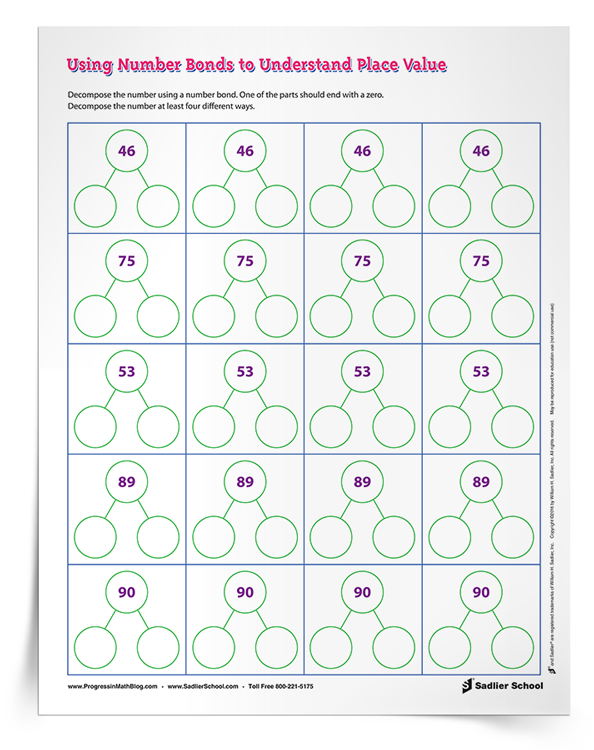September 6, 2016 mp-reasoning, k-2-number-and-operations-in-base-10, mp-problem-solving
Place Value Primary Resources to Promote Flexibility in Grades 1 and 2
By: Jeff Todd
Today, I am sharing some place value primary resources to develop understanding and flexibility in place values in the early elementary classroom. The ideas are appropriate for Grades 1 and 2, but also might be used with students in Kindergarten if they have a strong understanding of the ones, tens, and hundreds places. The download uses one of my favorite structures, number bonds, to help students develop their flexibility in decomposing numbers using place value.
 The Common Core State Standards use the following language to describe students’ developing sense of place value for Grades 1 and 2 (and beyond):
The Common Core State Standards use the following language to describe students’ developing sense of place value for Grades 1 and 2 (and beyond):
-
Use concrete models or drawings
-
Use strategies based on properties of operations
-
Explain their reasoning
Examples of concrete models and drawings are: linking cubes, base ten blocks, hundreds grids, 10 x 10 dot arrays, tens and ones cards, counters and cups, or bundles of sticks (such as straws or coffee stirrers). Student representations of these items could include tens frames, number bonds, and number lines. Use this list of primary place value resources to brainstorm ideas for lessons and stations for your class.
The Commutative and Associative Properties of Addition
The properties of operations that the Common Core State Standards refer to as students develop their place value understanding are the commutative and associative properties of addition. While students may not be able to name these strategies, they should be comfortable using them.
If you need a refresher, the commutative property of addition is that a + b = b + a, showing the idea that you can add numbers in any order. The associative property of addition is that (a + b) + c = a + (b + c) and allows for regrouping. These two properties are the tools that students will use to develop their flexibility in adding numbers, using place value concepts.
When students explain their reasoning about how they use models and drawings about place value and how they are using the associative and commutative properties to manipulate their models and drawing, it is an example of Standard for Mathematical Practices 1 and 3. Students use the models to explain to each other, to the class, and to the teacher how they are adding two numbers using place value.
One way that students grow in their flexibility is being able to explain how another student’s representation works. They can explain why a method different from their own works, the ways in in which it is similar or different. Orchestrating and modeling these discussions at the class level can promote this kind of discussion among students in small groups or with partners.
Using Number Bonds
One of my favorite primary place value resources is the number bond. I have written posts about number bonds—if you aren’t using them yet, they are one of the newer strategies used by teachers. The way that this activity promotes flexibility in place value is experiencing that ones, tens, and hundreds can be decomposed in different ways that are equivalent. For example, 45 can be decomposed as 4 tens and 5 ones, but also as 30 tens and 15 ones, 20 tens and 25 ones, and so on.
If you are using the Progress in Mathematics curriculum, this lesson would be a great tie in for the fact family lessons. In Grade 1, that would be lesson 3–13, and in Grade 2, that would be lesson 1–17. For students who need a challenge, extend the lesson to three digit numbers. With three-digit numbers, there are even more ways to decompose a number! For example, 342 can be decomposed into 3 hundreds, 4 tens, and 2 ones; or 1 hundred, 24 tens, and 2 ones; or even 3 hundreds and 42 ones.
If you are looking for some primary place value resources, I hope this list of concrete models and drawings is useful: linking cubes, base ten blocks, hundreds grids, 10 x 10 dot arrays, tens and ones cards, counters and cups, bundles of sticks (such as straws or coffee stirrers). Student representations of these items that could include tens frames, number bonds, and number lines.
You can also download the number bond activities for this post. There are two pages where students are asked to decompose a number in four different ways. The first page has problems using two digit numbers. The second page is blank, so that you can create your own activity, using two or three digit numbers.




